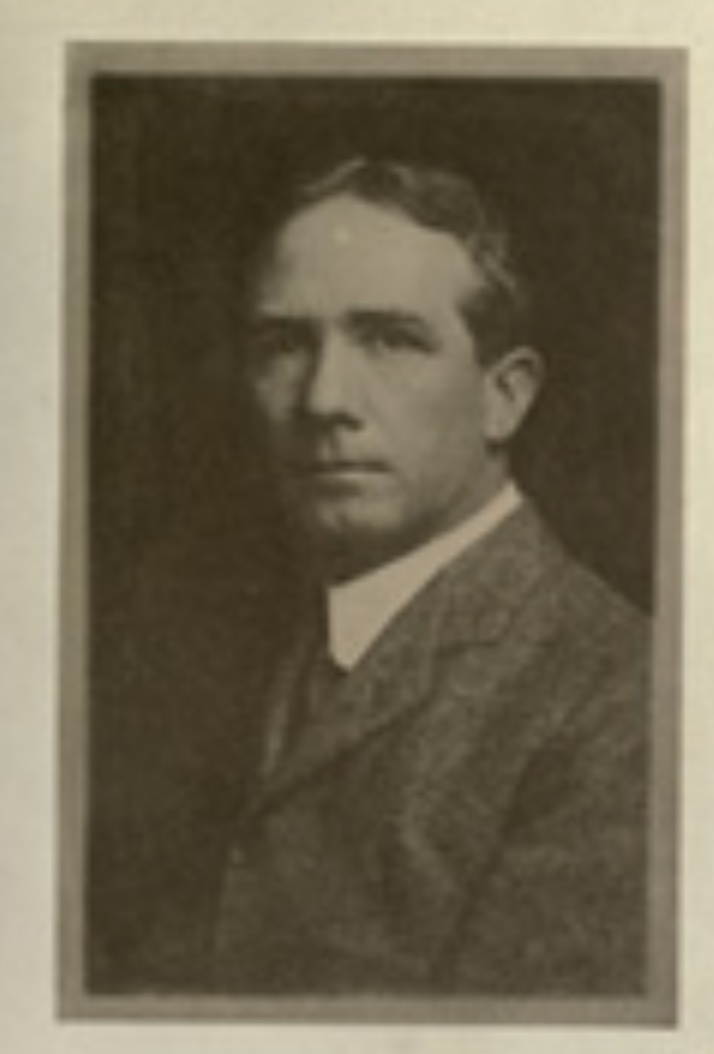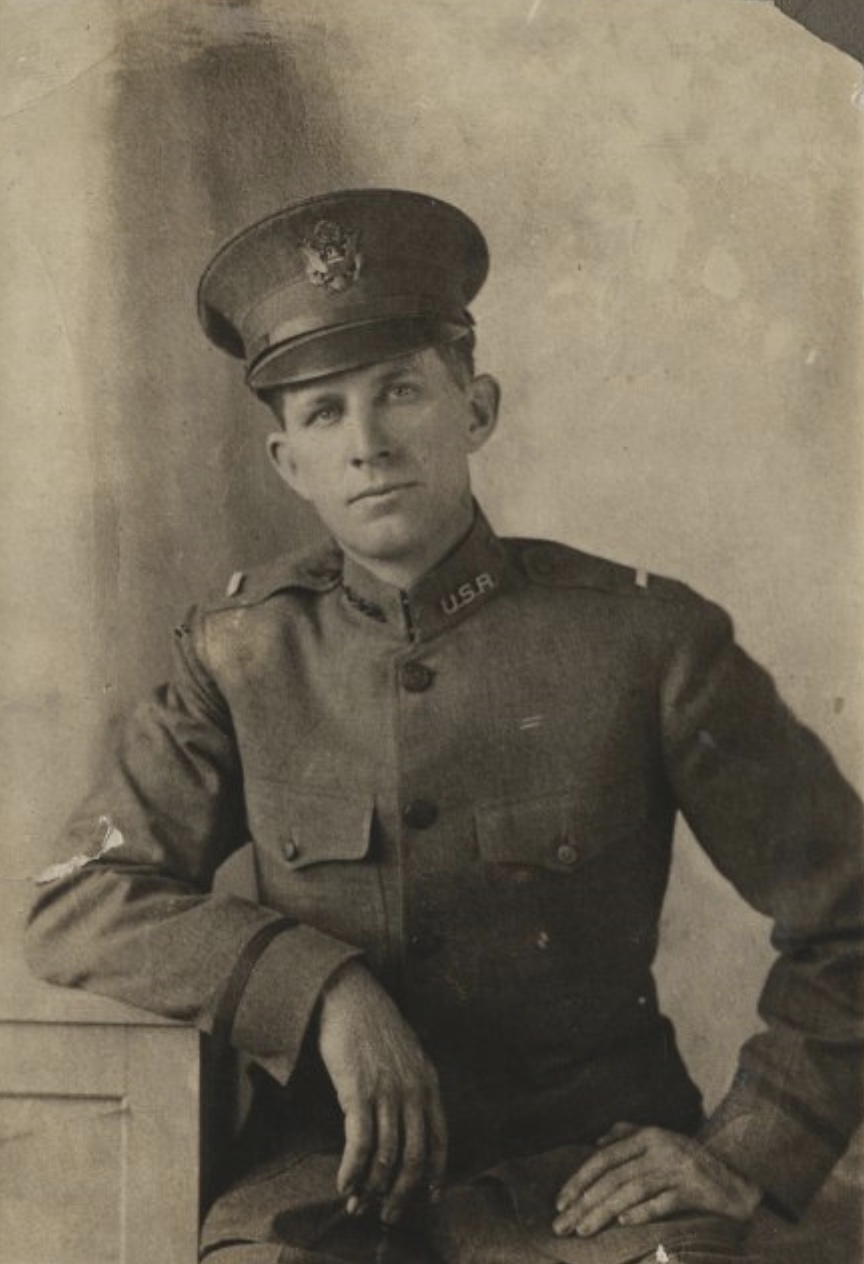



2nd Battalion, 20th Engineers
The Second Battalion
Note: Most of the text of this article comes from "TWENTIETH ENGINEERS -- FRANCE -- 1917-1918-1919"
The recruiting and training period of the history of our Second Battalion was at no time distinct from that of the First. The two units were drilled, equipped and organized together at the home camp, American University. Early in the fall one striking attribute of the Second came into universal notice in Forestry circles - the predominant western makeup of the Battalion. Partly by chance, partly doubtless by careful divisions of recruit arrivals the Second filled up largely with Pacific Coast officers and men, doubtless through a cautious propaganda, came to be known throughout the Regiment as the "Native Son" Battalion.

A photo of Company E, 2nd Battalion, 20th Engineers, at Camp American University in 1917
Training days, and the crossing to France, are covered in the story of the First Battalion. One incident on the voyage is worth remarking. Heavy weather was encountered south of Land's End, and during the night the breakers succeeded in battering a hatchcover and inundating several troop spaces. As one Co. veteran narrates: "There was no panic among the men, but the confusion among the messkits, shoes, clothing was terrible. Every time the vessel rolled, a roaring tidal wave raced across the decks, carrying everything before it, and bringing up with a bang against the side. All hands spent the next day in salvaging operations.''

A photo of 2nd Company (Co. F, 2nd Battalion) with names
Courtesy Sherman Boxx, grandson of Pvt. T. A. Rankin
Note the mascot dog at top center

Duffle bag of Private T.A. Rankin. Courtesy Sherman Boxx, his grandson.
Note the apparent nickname of the soldier, "The Stringbean Kid"
Arrived at St. Nazaire, the Battalion was for two weeks on a pretentious water-supply project. The duty was welcomed, if for no further reason than, in the grading operations, occasional roots and sticks were unearthed; these were smuggled into camp and utilized to eke out the scanty supply of fuel.
After two weeks, the unit received orders for travel to its various assigned stations. Headquarters, and Co's D and E, with a detachment of Co. F, were ordered to the Vosges region in northeastern France; the remainder of Co. F were detailed to join the First Battalion at Dax, in the southwest. Headquarters was established at the city of Epinal, capital of the Department of Vosges, and here was built up the organization that handled all the Forestry activities in the Advance Zone. The Epinal District embraced all that part of the advance area fronting on Lorraine, and the St. Mihiel and Argonne regions.

It was in the Advance Zone that the most tragic incident in the career of the battalion occurred, when a member of the battalion's Medical Detachment was killed near Varennes. Captain Harry E. McPherson, who was in charge of the mill at Ippecourt, near Soully, undertook a reconnaissance of newly won ground with a view to moving camp forward as soon as the lines were advanced. Accompanied by Lieut. Wilford Andrew Fair, Medical officer attached to the 2nd Battalion, and a Sergeant, the Captain traversed a clearing exposed to the enemy lines. A burst of machine gun fire opened, and the Captain fell mortally wounded. Lieut. Fair hurried to his assistance, regardless of the fusillade, and met death at his side. A determined stand by the Germans made the spot a no man`s land for several days; when the ground was finally won the bodies had been interred, and their location could not be determined.

Captain Macpherson |

Lieutenant Fair |
|---|
With the arrival of further increments of the Twentieth, the Epinal Districts assumed large importance. Units of the Fifth, Ninth, Tenth Battalions, and of the 41st, 42nd and 43rd Engineers, and detachments from other Forestry outfits, were incorporated. The activities of the western or Chatenois sub-district are reviewed in the story of the Fifth Battalion. North and east of Epinal the operations were of more permanent nature, cutting being continued in definite localities until the Armistice. At that time there were 3000 troops, of the Twentieth and auxiliaries, in the Epinal area.
Co. D (the 4th Co.) left St. Nazaire on the long journey to Lorraine, and landed three days later at their permanent camp, Granges, seven miles from the front lines in the Luneville sector. Here they built a mill and established logging camp, working under the added zest of proximity to the enemy. The outfit was more than once under fire, and hardly a man in the Company but took an occasional A. W. O. L. excursion into the lines.

After the Armistice the 4th Co. began to hit the bumps. The unit stood high in the priority list, by reason of their early arrival, and after turning over their camp to a detachment of the 46th Co., pulled for St. Nazaire, in company with Second Battalion Headquarters. Here, while waiting for sailing orders, they fell into the working habit, and installed nine miles of pipeline for the benefit of combat troops and German prisoners, who spent their days watching the two-stripers at work.
Even this was not enough. Late in February the outfit were loaded onto cars and shipped to Aureilhan, in the Pontenx District, Landes. The mill at Aureilhan, originally the station of Co. B of the Tenth Engineers, was operated by a detachment of the 11th Co., who cheerfully surrendered possession and returned to Lamanchs. It didn't take long for the 4th to get back to lumbering, though the unit's morale was undergoing an acid test.
In the midst of the tedious process of cutting standard ties into inch lumber, the 20,000 mill caught fire, late one night, and strenuous efforts failed to save it. Of the camp, only the barracks and warehouse were saved.
After two months of Aureilhan, genuine sailing orders finally materialized. The outfit left Aureilhan May 4th, and Bassens three days later.

An envelope from a soldier from Company E, 2nd Battalion, 20th Engineers. Note the stamp from the unit censor, 1st Lt. Volk.
Co. E, the 5th Co., were the pioneers in what was be the largest Forestry camp in France, excepting the Burnt Area. They located at the town of Eclaron, seven miles from St. Dizier, in Haute Marne. January 24th, 1918, they were joined by the 8th Co. (B of the Third Battalion), and jointly double mill, with a rated capacity of 40,000 board feet per shift. As was universal in the Twentieth, the rated capacity soon looked ready for sick call.
The Eclaron timber consisted chiefly of hardwoods, oak and beech. A large stand was available, and the operation strength was increased in March by the arrival of the 40th Co., later by several Service Companies. Logging was carried on both by trucks and railways, and extensive fuel production added to the camp activities.
Early in April a new Forestry district was created with the Headquarters organization of the 41st Engineers, later incorporated as the Thirteenth Battalion Hq., in charge.

The monotony of labor was varied at times by startling incidents. During the summer of 1918 the enemy lines were not too far away to keep Jerry from giving the neighborhood the occasional once over, and on several occasions bombing raids gave the the night shifts room for reflection. One sky visitor succeeded in messing up the baseball diamond in camp, but no serious damage ever occurred, thanks chiefly to effective camouflage.

After the Armistice the 5th Co. held the envied position of being the senior outfit in the district, and was groomed for speedy embarkation. However, it was not until February 23rd , 1919, that they started on the first leg of the journey, when they entrained for Dax, in the far southwest, and joined the First Battalion for the return to the States. They spent three weeks at Dax, two at Bordeaux, and sailed aboard the transport "Roanoke." After a wearying voyage, marked by a severe outbreak of the mumps, they landed at Hoboken, April 18th, 1919.

The clinical record for Private Elmer L. Phelps for the amputation of his small toe on his right foot. The other four toes had already been amputated after a logging accident.
Co. F (later 2nd Company) was divided at St. Nazaire, one detachment remaining with the Battalion organization for the Advance Zone duty, the other repairing to Dax with the First Battalion. The southern detachments were assigned to a pine operation at the hamlet of Houeilles, in the Department of Lot-et-Garonne. A small French portable sawmill was first operated, while construction of a American 10 M mill was started. The early days on the job were marked by considerable discomfort from lack of shelter and hitches in the ration supply.

Very interesting letters from Private P.W. Brown, Company F, to his sister in California
Cutting continued at Houeilles until the front of February, 1919. The detachment was then moved to Dax, where it was merged with the units there for re-equipment and drill, and for the long trail back to Hoboken.

Click on this envelope to see a letter from Sergeant T. E. Holman to his cousin in Ohio.
Note the censor's stamp on the bottom left of the envelope.
Officers of 2nd Battalion, 20th Engineers:
Battalion Commander - Major Samuel O. Johnson
Engineer Officer - Captain Fred F. Horstkotte
Adjutant - Captain Fred F. Spencer
Supply Officer - First Lieutenant Mark R. Ethell - see his gas mask below



Company D (4th Company)
Company Commander - Captain John C. Perry
First Lieutenants - William H. Crosson, Roy W. Pilling and Lawrence R. McCoy
Second Lieutenant - Myron H. Glover
Company E (5th Company)
Company Commander - Captain W. D. Brookings
First Lieutenants - W. D. Volk, C. C. Kelley, and F. R. Prince
Second Lieutenant - E. S. Brush
Company F (2nd Company)
Company Commander - Captain James C. Long
First Lieutenants - Edwin D. Woodruff, Marion Nine and Walter O. Crosby
Second Lieutenant - Maurice L. Johnson
Medical Detachment
Battalion Surgeon - Captain J. H. Swafford, M. R. C.
First Lieutenants - W. A. Fair (KIA) , M. C., and R. H. Rowdybush, D. C.